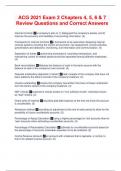Exam (elaborations)
ACG 2021 Exam 2 Chapters 4, 5, 6 & 7 Review Questions and Correct Answers
- Course
- Institution
Internal Controls a company's plan to 1) Safeguard the company's assets, and 2) Improve the accuracy and reliability of accounting information. (4) Framework for Internal Controls a framework to be used when designing internal controls systems including the control environment, risk assessment, co...
[Show more]



